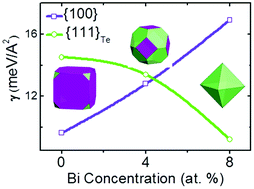Surface-energy engineered Bi-doped SnTe nanoribbons with weak antilocalization effect and linear magnetoresistance†
Abstract
The rational design of semiconductor nanocrystals with well-defined surfaces is a crucial step towards the realization of next-generation photodetectors, and thermoelectric and spintronic devices. SnTe nanocrystals, as an example, are particularly attractive as a type of topological crystalline insulator, where surface facets determine their surface states. However, most of the available SnTe nanocrystals are dominated by thermodynamically stable {100} facets, and it is challenging to grow uniform nanocrystals with {111} facets. In this study, guided by surface-energy calculations, we employ a chemical vapour deposition approach to fabricate Bi doped SnTe nanostructures, in which their surface facets are tuned by Bi doping. The obtained Bi doped SnTe nanoribbons with distinct {111} surfaces show a weak antilocalization effect and linear magnetoresistance under high magnetic fields, which demonstrate their great potential for future spintronic applications.



 Please wait while we load your content...
Please wait while we load your content...